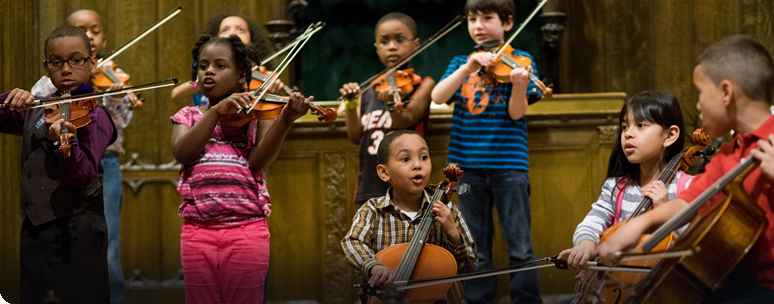Drawing inspiration from Eric Booth's two-day residency earlier in the semester, CMW resident musicians have undertaken teaching experiments of their own creation during March and April. At a recent staff meeting, Minna candidly shared her teaching experiment, including its frustrating results, and then very generously agreed to write up the details for the blog.
Minna's Experiment
Questions: Are students more engaged and excited if they get to be “in charge” of their learning? Will it impact their enthusiasm for a) coming to lessons, and b) practicing during the week?
Experiment: Each week in their lessons, let them help me create the lesson plan for the day, including something they want to do. Together, come up with the list of things that they are going to work on over the week for their practice charts.
Collecting evidence: Keep a log of what the lesson was like, whether the students were more or less engaged; ask and record how much practicing they did over the course of the week.
Results
What I expected: I expected that students would have ideas about what they did or didn’t want to do in lessons, and by having the chance to be more in charge of their own learning, would feel more intrinsically motivated.
What happened: I ended up doing this primarily with my Phase I students, and only one of my Phase II students. Among my younger students, most of them didn’t really know what they wanted to do in the lesson; I think they weren’t used to being asked (or in some cases they didn’t care). Early on, my questions would be met with a shrug or “I don’t know.” So I would primarily shape the lesson, but then ask them questions to get their opinions (i.e. what kind of bow stroke should we try this scale? What tempo should we try the note reading? Where should we start in a piece? How many times should we repeat something?) Usually that succeeded in drawing the students out so that they felt more comfortable voicing their opinions and consequently felt more engaged in the lessons. In one particular student’s case, by the third week, he knew right away what he wanted to do.
However, this didn’t seem to affect how much practicing they did over the week. And even a fun lesson the week before didn’t seem to carry over to the following week’s lesson—they would come in for the lesson with blank, long faces, and sometimes noncommittal shrugs when I asked them how they were. And I would have to start all over again. I gave up asking about their home practice, because it really didn’t seem to change at all. Some weeks, I found myself very frustrated with this aspect…
Mini-success story: "D" has been really unengaged the whole year, even if I try to engage him by letting him choose pieces, etc. He seems a little stuck by the note reading thing because it slows him down. He can learn a piece much faster by ear, but we’ve been persisting with the note reading. Every lesson, when I would ask what he wanted to start with, he would shrug. In conversation one day, I was asking him what he liked, and he told me about this TV show “Minute to Win It” where you have to do something in under a minute to win a prize. So we started doing that with his note reading flashcards (17 of them). His dad was the timekeeper. We started on April 14th and at first, he could only get about half of them in a minute. Then as we continued to do it week-to-week, he got more right. Finally, he got them all in a minute, and had the biggest smile on his face at the end of it! I had never seen him so animated.
Analysis
Looking back, I realized my frustration came across in the way I was teaching and made the lesson not fun for both the student and myself. But it leaves me with the following question: How do you come in with an open mind and heart, and a smiling face when a student a) doesn’t seem to care at all, b) hasn’t touched his/her instrument since the last time you saw him/her, and c) you’re treading water and teaching the same thing over and over again?
What I learned: It takes a lot more to ignite kids’ intrinsic motivation, especially when there’s not a lot there to begin with. It’s not enough to let them choose the material (pieces) and help direct the lesson. And perhaps it’s something that builds over time—as they experience a sense of ownership in lessons and continue to have fun in their lessons, do they become more invested?
Overall, the experiment made me pay more attention to where each student was when they came into the lesson. And I made an effort to meet them where they were, and then build on that. Regardless of what intrinsic motivation they have, students always come in with something on the brain, maybe something bad happened at school, or they just got yelled at by their parents, or something else is going on for them…For pretty much everyone, it was the interpersonal connection that I made that helped us to make the material more interesting. It made me more alert as a teacher to try to really see the student—and not just focus on pushing my own agenda.
-Minna Choi, Fellowship Program Director/Resident Musician
